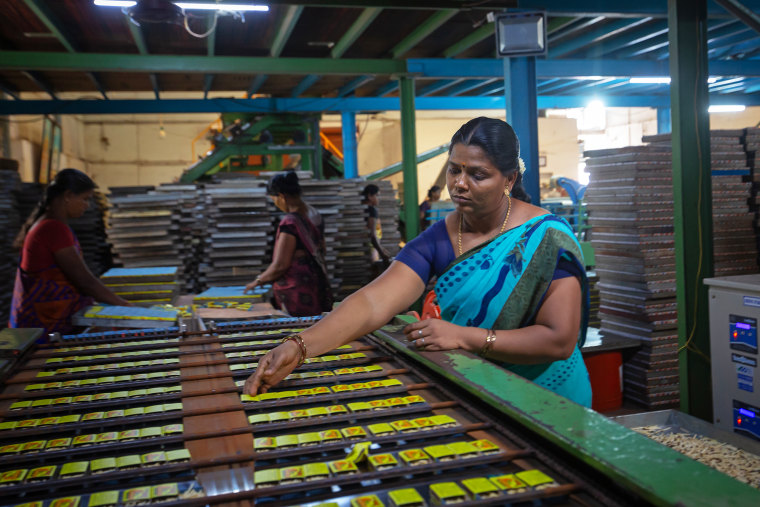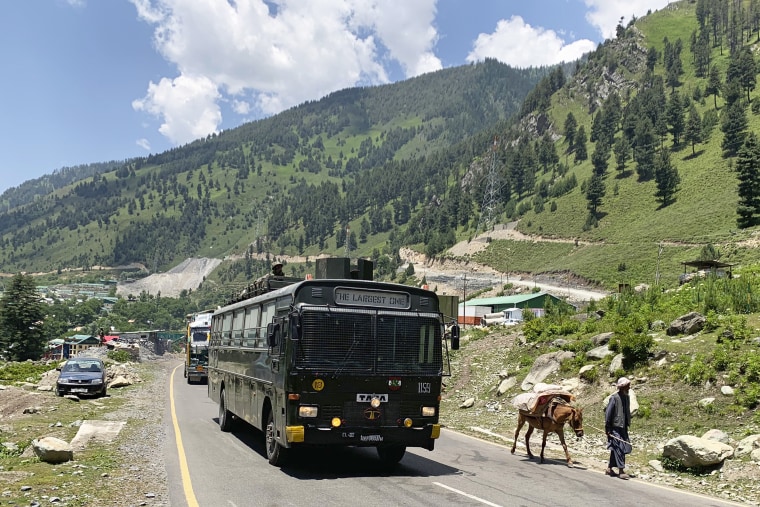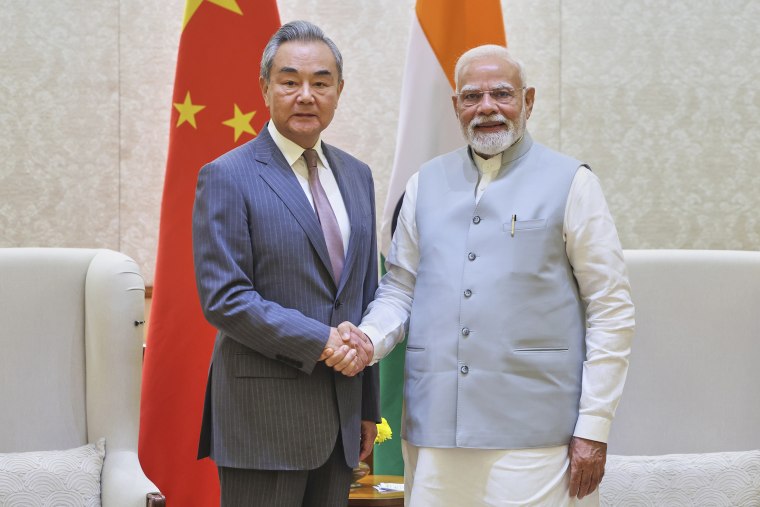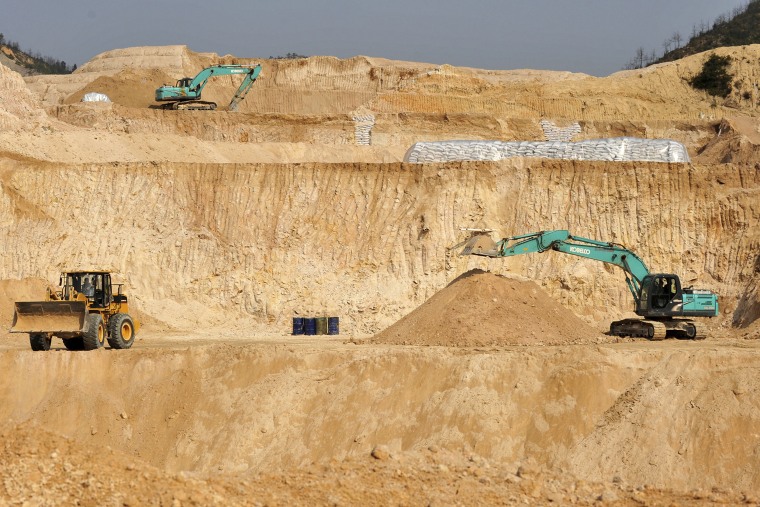Share this @internewscast.com
As a crucial security ally in Asia and a strategic counterbalance to China, India’s significance to the United States is growing. However, President Donald Trump’s tariffs could inadvertently be driving India towards a closer relationship with Beijing.
This weekend, Indian Prime Minister Narendra Modi is visiting China for the first time in seven years to participate in a security forum with global leaders, including Russian President Vladimir Putin.
On Sunday Modi and Chinese President Xi Jinping met in Tianjin, where China is hosting a summit of the 10-member Shanghai Cooperation Organisation.
Chinese President Xi Jinping expressed to Modi that China and India, as the world’s two most populated nations, should act as “partners rather than rivals,” suggesting that the “dragon” and “elephant” should unite.
Modi told Xi that they were “committed to progressing our relations based on mutual respect, trust and sensitivities.”
This dialogue occurs shortly after the Trump administration decided to double tariffs on Indian imports to 50%, a response to India’s purchase of Russian oil. This significant tariff, among the highest imposed on a U.S. trading partner, has sparked fears that it may encourage India to align more closely with China, despite historical tensions.
“Until recently, the India-China relationship was not just bad, but very bad, with minimal communication between them,” stated Kishore Mahbubani, a seasoned Singaporean diplomat and the former president of the United Nations Security Council.
“Credit must be given where it’s warranted: President Trump’s imposition of a 50% tariff on India presents one of the most significant challenges India has faced in recent years,” Mahbubani remarked during a Wednesday event hosted by the University of Hong Kong’s Centre on Contemporary China and the World.
India, along with China, is a top purchaser of Russian crude oil, which Trump says is helping to fund Moscow’s war on Ukraine. New Delhi says such criticism is “unjustified and unreasonable,” and that the U.S. previously encouraged it to buy the oil to keep global prices from soaring as Western countries suspended their purchases.

While India and China share a common grievance over Trump’s tariffs, which in China’s case have reached as high as 145%, analysts say their relationship still faces major challenges and that Modi’s China visit is mainly a symbolic display of resilience.
“Xi wants Modi and India to show that they are working with him and with China to the extent that they are not following the Trump or U.S. lead in containing China,” said Steve Tsang, director of the China Institute at the SOAS University of London.
Earlier this month, the Chinese ambassador to New Delhi delivered a rare public defense of India against the tariff increase, calling the U.S. a “bully.”
It was a major step up from the deep freeze that began in 2020 with a border clash in India’s Himalayan region of Ladakh that killed at least 20 Indian and four Chinese soldiers and plunged relations so low that the two countries suspended direct flights.

Only seven months ago, India was entering Trump’s second presidential term in a relatively strong position, with Modi among the first world leaders to visit his “dear friend” at the White House.
But tensions soon arose, with Trump complaining that Apple was producing iPhones in India instead of the U.S. India also rejected Trump’s claim that he brokered a ceasefire in its four-day conflict with neighboring Pakistan.
New Delhi was further incensed weeks later when Trump hosted Pakistan’s powerful army chief at the White House in an unprecedented meeting.
“The Indians saw this as a slap in the face for them,” Mahbubani said. “So there is now, even as we are speaking, a tremendous amount of re-evaluation going on in Delhi about where India’s place in the world is.”
At the same time, China and India have been moving cautiously to restore their relationship, reaching a deal to resolve their 2020 border standoff and announcing the resumption of direct flights.

But not everybody is convinced about China extending a friendly hand, and the two countries still have major differences.
One of the biggest is China’s ties with Pakistan, India’s archrival and a fellow nuclear power. During their conflict in May, Pakistan said it had used Chinese-made J-10C fighter jets to shoot down Indian military aircraft.
“There was a huge step up in the kind of assistance that the Chinese were providing Pakistan, not merely in terms of selling them equipment and platforms, but on intelligence, surveillance, reconnaissance,” Gautam Bambawale, a former Indian ambassador to Beijing, said in an interview. “So we will go by actions on those things.”
Bambawale said it could take “months, if not years” for the relationship to return to where it was before 2020, let alone reach new heights.
Though India and China are strong trading partners, that has not been enough to smooth over other diplomatic issues.
Earlier this month, after a meeting in New Delhi between Chinese Foreign Minister Wang Yi and his Indian counterpart, S. Jaishankar, Beijing released a readout suggesting Jaishankar had acknowledged that Taiwan, a self-governing island democracy, “is a part of China.”
When asked if Jaishankar made that statement, an Indian government official who was familiar with the discussions between the diplomats but not authorized to speak to the media, told NBC News that there was no change in India’s position on Taiwan.
“We stressed that like the rest of the world, India has a relationship with Taiwan that focuses on economic, technology and cultural ties,” the official said.
The clarification, which was also reported by Indian news organizations, prompted Beijing to double down, saying it was a “surprise” and “inconsistent with the facts.”
“It would seem that some people in India have tried to undermine China’s sovereignty on the Taiwan question and impede the improvement of China-India relations,” Chinese foreign ministry spokesperson Mao Ning said.

The two countries also have other border disputes as well as a manufacturing rivalry that may only worsen as companies try to shift production from China. China, which is worried about technology transfer, has imposed curbs on the export of rare earth materials to India and recalled some of its nationals working in specialized roles.
“The meeting between Modi and Xi will not remove the structural issues between India and China,” Tsang said. “But the big issue for Xi outside of China now is U.S. pressure, and making sure India does not appear to be on the U.S. side is therefore significant.”
“On this occasion, optics does matter,” he added.












